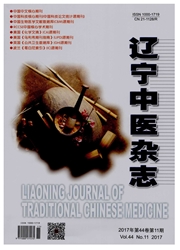

 中文摘要:
中文摘要:
目的:探讨MRI-DWI(核磁共振扩散加权成像技术)在热带地区急性缺血性中风中医证型的差异性,观察各中医症型的预后差异。方法:回顾性收集2010年8月—2013年12月临床及MRI确诊无意识障碍急性缺血性中风患者134例,按1993年颁布的《中药新药治疗中风病的临床研究指导原则》将他们分为肝阳暴亢、风火上扰(2例),风痰瘀血、痹阻脉络(68例),痰热腑实、风痰上扰(13例),气虚血瘀(49例),阴虚风动(2例)5组,并分析它们脑梗死DWI图像资料。分别评价患者治疗前、治疗后2周及治疗后3个月的神经功能缺损程度及患者病残程度,作为中、远期疗效指标,并分析各中医证型间的远期疗效差异。结果:三亚热带地区的急性缺血性中风以"瘀、痰、气虚"为主;所搜集资料中经络组病例中腔隙性脑梗塞为80例,占比约57.9%,分布最为广泛。由于肝阳暴亢、风火上扰及阴虚风动证型各仅有2例,代表性较差,不予分析。经Kruskal-Wallis秩和检验对3组DWI显示的脑梗死容积进行比较,得H=9.229,P=0.010,差别有统计学意义。再经单因素方差分析对3组的ADC值进行比较,得F=3.393,P=0.183,差异无统计学意义。最后进一步用Kruskal-Wallis秩和检验对3个不同中医分型组的疗效进行比较,差异无统计学意义。结论:MRIDWI显示的梗死容积与热带地区急性缺血性中风中医证型间有一定的关系,其差异性无统计学意义;而DWI的ADC值在评估热带地区急性缺血性中风中医证型意义不大。各中医证型其远期疗效差异性没有统计学意义。
 英文摘要:
英文摘要:
Objective: To investigate the value of MRI- DWI in Traditional Chinese Medicine( TCM) syndrome of acute ischemic apoplexy in tropic area. Methods: The data was collected retrospectively from August 2010 to December 2013 in Sanya Hospital of Traditional Chinese Medicine. A total of 134 patients( 89 male and 45 female; mean age = 67,range = 37- 87),clinically and by MRI diagnosed as acute ischemic apoplexy without consciousness disorders,were included for further analysis. According to Clinical Research Guidelines of New Traditional Chinese Medicine in Treating Apoplexy( 1993),the patients were divided into 5 groups: disturbance of wind and fire due to hyperactivity of liver- Yang group( 2 patients),obstruction of meridian due to wind- phlegm and blood- stasis group( 68 patients),disorders of wind- phlegm due to phlegm- heat and excess of Fu- organ group( 13 patients),Qi- deficiency and blood- stasis group( 49 patients),Yin- deficiency and wind generating group( 2 patients). MRI- DWI data of patients was analyzed. Results: There were only 2 cases in either disturbance of wind and fire due to hyperactivity of liver- Yang group or Yin- deficiency and wind generating group. Considering the representation,these 2 groups were removed. Kruskal- Wallis test was used to investigate the differences of DWI infarction volume of three TCM- syndrome groups. The results were H = 9. 229 and P = 0. 010. One- way analysis of variance was used to investigate the differences of ADC value of three TCM- syndrome groups. The results were F = 3. 393 and P = 0. 183,meaning the difference was not statistically significant. Kruskal- Wallis test was used to investigate the differences of long- term efficacy in three TCM syndromes of acute ischemic apoplexy. The results were,meaning the difference was not statistically significant. Conclusion: MRI- DWI infarction volume is valuable in evaluating TCM syndrome types of acute ischemic stroke in tropical area,while ADC value shows little. The difference o
 同期刊论文项目
同期刊论文项目
 同项目期刊论文
同项目期刊论文
 期刊信息
期刊信息
